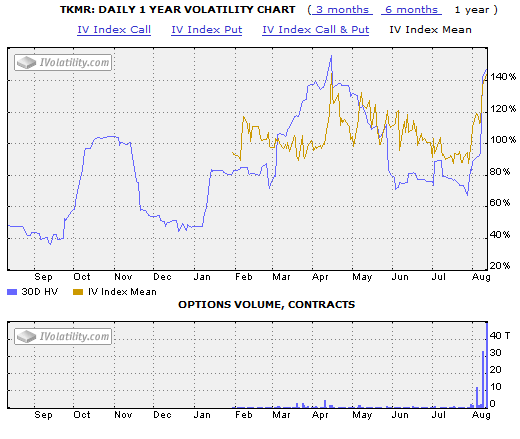The S&P500 closed today above 2000 for the first time, marking a major milestone in the post-implosionary bull market of 2009. No doubt, traders are nervous of the melt upwards in US indexes as the Fed trims their balance sheets. Perplexingly, the $VIX still indicates a degree of complacency relative to the year:
The short-term realized volatility of the VIX (IV10) has retraced levels seen prior to the brief scare in July where markets become suddenly lucid of the risk that Ebola, Russia/Ukraine, and ISIS posed. Markets are not entirely discounting that risk however, as the 30-day forward looking implied volatility sits elevated relative to the near-term historical (HV10 specifically) volatility. Looking at the increasing trend of sales in put options on the fear index shows that some are willing to bet that volatility still has room to go down.
The S&P500 itself has been flirting above and below the 2000 milestone for the past two days, showing uncertainty of whether this millennial mark can maintain despite the trimming of the Fed's balance sheet and the looming possibility of interest-rate risk.
The sideways action of the S&P500 is reflected in the very diminished 10-day realized volatility, however Wall Street is starting to place their bets.
Below is the options skew for $SPY:
Based on options sales in the $SPY, one trader is betting on S&P upside to the 2002.5 level with the purchase of 5200 call options on the index. This level acted as strong resistance in this afternoon's trading.
On the flip-side, a bearish ante was upped today with the sale of a 10,000 put option spread for the 19300 and 19900 levels. This trader is betting on downside retracement to the levels seen earlier this month before the magnificent 65-handle, 10 trading day rally:
 |
| The VIX as of today's close. HV10: White; HV30: Gray; IV30: Red |
The S&P500 itself has been flirting above and below the 2000 milestone for the past two days, showing uncertainty of whether this millennial mark can maintain despite the trimming of the Fed's balance sheet and the looming possibility of interest-rate risk.
 |
| $SPY: HV10: White; HV30: Gray; IV30: Red |
Below is the options skew for $SPY:
Based on options sales in the $SPY, one trader is betting on S&P upside to the 2002.5 level with the purchase of 5200 call options on the index. This level acted as strong resistance in this afternoon's trading.
 |
| Largest sales in the $SPY today |
On the flip-side, a bearish ante was upped today with the sale of a 10,000 put option spread for the 19300 and 19900 levels. This trader is betting on downside retracement to the levels seen earlier this month before the magnificent 65-handle, 10 trading day rally:
From either perspective, bet on increased chop in the days ahead.
 |
| Largest VIX sales for Aug. 26, 2014 |
A 15000-lot 18/23 call spread was opened today for the Oct. $VIX expiry. For those of you betting on increased volatility as we head into the fall, the current 30-day implied volatility of the VIX sits near 70, which indicates that the IV30 of the VIX has only been lower 33% of the time.
Good luck tomorrow.
















































